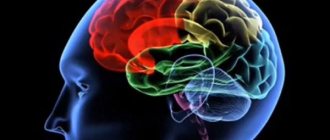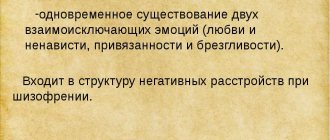There is not a single person in the world who is free from the feeling of fear. What is the psychology of fear based on, why is a person born with a feeling of fear? Psychologists reassure us that fear is an innate indicator of danger.
It is necessary for survival in a world full of dangers. But sometimes this indicator gets lost, changes intensity, becomes irrational and becomes a panic attack. In this case, you need to start fighting the monster before it causes a lot of trouble.
I was able to cope with irrational fear with the help of breathing exercises and meditation. But first you need to find the root of your fear in order to tear it out completely. We'll talk about this in the article.
Physiology of fear
Find out what awaits you today - Horoscope for today for all zodiac signs
Due to numerous requests from subscribers, we have prepared an accurate horoscope application for mobile phones. Forecasts will arrive for your zodiac sign every morning - it's impossible to miss! Download for free: Daily Horoscope 2020 (available on Android)
First, let's look at this issue from a physiological point of view. What happens to a person when a feeling of fear appears? The brain and body activate all their reserves to help a person avoid danger. This condition is characterized by:
- production of stress hormones;
- activity of the peripheral nervous system;
- increased pain threshold;
- increased muscle activity and reaction speed;
- increased contractions of the heart muscle and breathing;
- sweat production and blood pressure increase;
- the lumen of blood vessels decreases;
- stopping the digestion process;
- dilated pupils and the appearance of tunnel vision;
- Blood sugar levels increase noticeably.
These changes in the body are necessary so that a person can quickly run away and hide from danger or provide physical resistance. But if this does not happen (in the case of irrational fear), then such a load on the body is very dangerous.
In constant stressful situations, it is possible to acquire a chronic disease. Therefore, it is necessary to give the body time to recover from the increased load.
Why is emotional stress so dangerous for the body? Because the brain does not distinguish between real and irrational danger: it gives commands to produce the appropriate hormones and changes the physiology of the body to eliminate the physical danger. The brain identifies absolutely everything as danger:
- stress at work;
- family quarrels;
- international news on TV.
The brain gives the command to develop defensive reactions, and the body begins to destroy itself. Therefore, anxiety, excitement and emotional showdowns are dangerous to human health.
Terribly interesting: how, why and why we experience fear
Our lives are full of fears. The 36-letter term for the fear of long words is hippopotomonstrosesquippedaliophobia. And if you haven’t broken out in a cold sweat right now, then you’ve definitely broken your tongue over this word. By the way, fear of fractures is catagmaphobia. There are people who are not afraid of anything at all, and there is nothing good about that. The mechanism of fear from a biochemical point of view is damn simple - it's like a one-button switch on your wall. But everything is much more interesting if you look at human fear in the context of other sciences.
Sasha Epstein
May 25, 2020 11:03
If you are threatened by a real or perceived disaster (height, fire, walking through the night Lyubertsy or a long word), then your body turns on the reaction. The evolutionarily conserved protein stathmin, the same switch involved in regulating the dynamics of microtubules (intracellular structures, a cytoskeletal component necessary for cell division), triggers a special mechanism. Stathmin is also called the “fear gene.” An almost academic test of molecular genetics shows that those mice whose stathmin gene was blocked were much calmer than their relatives in open space and did not avoid potential dangers.
Neuroscientists identify two ways in which fear develops. The first, which is also fast, allows us to instantly respond to signs of danger, but often triggers as a false alarm. Scientifically speaking, an emotional stimulus, reflected in the sensitive nuclei of the visual thalamus, closes on the amygdala nuclei, causing an emotional response. In Russian, this is the same scream that we make when someone creeps up from behind. It's like a cheap car alarm that goes off when someone passes by - not always effective, but always loud.
The second neural pathway of fear in our brain is a much more complex process. An emotional stimulus, reflected in the sensory nuclei of the thalamus, ascends to the sensory parts of the cerebral cortex and from them is sent to the nuclei of the amygdala (almond-shaped) complex, forming an emotional response. The first path is responsible for the development of the body’s basic reaction; it reacts quickly and is accompanied by a large number of errors. The second is slower, but more balanced. With a normal psyche, it blocks the initial panic, and we begin to think actively, but constructively.
Often our nerves go crazy, and with phobias the second pathway functions inadequately, which leads to the development of an irrational feeling of fear in response to stimuli that do not pose a danger. In other words, no matter how much you tell a peladophobe that there is nothing scary about a man’s bald head, the bare back of his head will still horrify him. What's interesting is that both the first and second neural pathways of fear end in the hypothalamus, a section of the brain responsible for the most ancient survival instincts. That is, the final center is the same in both cases, but what a different reaction!
In 1929, a rare recessive genetic disorder was officially documented by Erich Urbach and Camillo Wiethe. Until recently, it was believed that patients whose amygdala was destroyed due to Urbach-Wiethe disease had no fear at all. However, the latest research has shown that it is still possible to frighten such people if you use air inhalation with a high carbon dioxide content (at least 35%). The disease is quite rare, with fewer than 300 cases reported to date and is most common in South Africans.
The biggest fear these days is social, and it relates to public speaking. Psychologists say that the crux of the problem lies in the threat to self-respect, self-esteem and self-efficacy, because when we speak in public, we give others the opportunity to evaluate us. What makes this particular phobia even more frightening is the fact that it cannot be denied with the self-hypnosis of “this will never happen to me”, as with some phobias.
Even though fear is a basic defense mechanism, we don't always avoid it. People get high from skydiving and watching horror films, riding roller coasters and bungee jumping. The person understands that the actual risk of these actions is negligible, and because of this underlying awareness, he experiences excitement and arousal similar in nature to sexual. Moreover, since fear sometimes provokes the release of adrenaline into the blood, which has a stimulating effect on the central nervous system and increases the body's resistance to stress and shock, for some it becomes a drug. However, most adults and adolescents are able to realistically assess the level of threat and safety that comes from dangerous stimuli. This is why children get scared much more easily than adults: they simply have less experience in judging. A small child may perceive a harmless bug as a serious threat to his or her safety.
By the way, about beetles. Scientists at Carnegie Mellon University in Pittsburgh found that 11-month-old girls quickly learned to associate pictures of spiders and snakes with scary facial expressions, while boys did not. From an evolutionary perspective, this makes sense, since women in the past encountered crawling creatures on a regular basis while gathering food. And the protective mechanism in the form of fear could ensure the safety of both mothers and their children. Men, on the other hand, often had to take risks while hunting, and a similar mechanism of reaction to spiders and snakes was turned off during evolution so that our ancestors were more efficient hunters. Therefore, fear is not just a necessary defense mechanism, part of the instinct of self-preservation, but a kind of evolutionary engine, which is not worth being ashamed of. By the way, fear of fear is phobophobia.
Types of fear in psychology
A scientific approach to psychology has made it possible to comprehensively study the state of fear and its types. The Austrian school of psychology, led by S. Freud, identified real and neurotic fears.
American psychiatrist Kaplan identified constructive and pathological fear. However, these classifications are united by one idea: there is real and unreal (irrational) fear.
Real fear poses a threat to human life and health. For example, fear of fire or heights, wild animals in the forest, or frostbite in winter. This type of fear stops a person from doing unreasonable things and saves his life.
But the second - irrational - type of fear leads to mental illness if you do not provide proper resistance to this illusory reality.
Domestic psychiatrist Yuri Shcherbatykh classified fear as follows:
- biological;
- social;
- existential.
Biological fear is fear for your life and health. This is an innate sense of danger that protects a person from all types of dangers.
Social fear is the fear of punishment, public censure and disapproval. In some periods of the development of human society, he saved from execution, prison and reprisals. In calm times, this is the fear of losing trust, social significance and a warm place in the sun.
Existential is a non-existent, irrational fear. This is the fear of what cannot be verified experimentally. For example, fear of hell or God's punishment.
People are also afraid of ghosts and vampires, which no one has seen except notorious dreamers. Nevertheless, the belief in the non-existent has survived to this day in its original form. Decades of atheistic “religion” could not stop people from freeing their minds from horror stories.
Each age social group of people is obsessed with their own specific phobias. If a junior schoolchild is afraid of a strict “teacher”, then a woman after 30 is afraid of wrinkles on her face.
There are other classifications of fears, but they are all somehow connected with reality and fiction. Each group of fears is divided into numerous subgroups called phobias.
Modern phobias:
- death - thanatophobia;
- loneliness;
- rejection;
- aerophobia;
- terrorism;
- height;
- poverty;
- natural disasters;
- intimacy, relationships.
Psychologists believe that the emotion of fear in small quantities is useful because it separates what is safe from what is dangerous. Fear becomes pathological when it goes beyond the reasonable and turns into an irrational phobia: a person is afraid of what does not yet exist.
However, a modern approach to the psychology of fear has made it possible to look at it from a different angle. Scientists have found that very often a person is afraid of exactly what he subconsciously desires and would like to try.
At what point does fear stop serving us and begin to hinder us?
That is, it turns into a phobia - an irrational fear of specific objects and phenomena .
But the fact is that the second feature of fear is that it is a reaction to any danger , to everything that you consider dangerous, even if it is not.
Imagine two boxes, one of them says Dangerous , the other says Safe . Any, absolutely any thing, and any, absolutely any phenomenon and event can be put either in the first box or in the second. And that’s exactly what we do with the world around us – we put it into boxes.
What determines which box what goes into? Usually from the first contact with an object that is new to you. And usually in childhood. If the contact is good and positive, go to the Safe box. If the object, for example, a feisty cat, purrs and bites, I don’t want to be friends with you, go to the Danger box.
And the sad thing is that this acquaintance can take place in absentia , without direct contact. For example, a child saw a cat for the first time in his life. He still doesn’t know anything about him, but his parents are already saying: ayyyy, don’t touch him, he’s flea-ridden, it’s dangerous. And that’s it, I went to the Danger box.
Naturally, things can move from box to box , for example, from safe to dangerous. When an object shows itself from the other side, and sometimes purely by accident.
Age
A person still “in the embryo” senses danger. It is no secret that during an abortion, the embryo is “saved” from medical instruments, i.e. shows fear at a behavioral level. According to other sources, the first fears appear in infants around seven months. Young children are usually afraid of loud noises and flashes of light, loneliness, darkness, heights, etc.
In addition to these natural fears, society, and primarily the family, gradually begins to influence.
Don't touch - you'll break it, You can't - you won't be able to, Don't climb - you'll fall... So the child begins to learn that the world is dangerous, and he is small and weak in it.
Thus, through knowledge of the world and further socialization, the child learns to be afraid of many things - both external objects, such as something hot or sharp, animals or people associated with something unpleasant (for example, angry dogs and dentists), and social , such as poor grades at school, fear of public speaking and others directly related to the social environment and the individuality of the subject in it.
An interesting fact is that some studies suggest that in large families, middle children have less fears than their brothers and sisters.
I also found statistics according to which the number of brave people increases with age (from preschoolers to middle teenagers), regardless of gender. The maximum number of brave boys and girls occurs in adolescence, and then the number of brave girls decreases, while boys remain at the achieved level (N. D. Scriabin, 1974). However, here we are talking about averages, and individual results may differ significantly from them.
Etymology
The word “fear” comes from the Proto-Slavic form straxъ, from which, among other things, came: st.-slav. etc.-Russian fear, from where already Russian, Ukrainian and Bulgarian fear, Slovenian strȃh (gen. strȃha, strahȗ), Czech, Slovak and Polish - strach; The original meaning is “numbness”, which is similar to the Lithuanian stregti, stregiu “to become numb, turn into ice”, and the Latvian strēǵele “icicle”. Comparison with Lat. strāgēs "devastation, defeat, throwing to the ground" is disputed. It is also compared with the Latvian struõstêt, struõstît “to threaten, to strictly warn.”
Facial expressions and gestures
It is well known that people tend to communicate not only through speech (i.e. verbally), but also non-verbally - through intonation, facial expressions and gestures. According to various sources, at least 50% of information is transmitted non-verbally, and while it is easy to tell a lie, it can be more difficult to deceive physically. There are many theories of basic emotions and most of them involve fear, accompanied by corresponding facial expressions and postures. Let me clarify that Charles Darwin also drew attention to the connection between emotions and instinctive behavior. It was discovered that the rudiments of facial expression were characteristic even of children who were blind from birth and did not have the opportunity to learn through imitation, but it was much paler. These basic manifestations of emotions are innate and are characteristic not only of humans, but also of higher animals - primates, dogs, etc.
By facial expressions we mean movements of the facial muscles, a universal way of expressing emotions, regardless of race or social class. Each of us intuitively recognizes a frightened person by the following signs:
The pupils dilate and the eyes open as wide as possible in order to notice danger in time. The lips are compressed and stretched horizontally, the corners of the mouth are pulled back, teeth can sometimes be unconsciously shown, the eyebrows are raised and brought together - depending on the degree of fear, this can be expressed more or less clearly. If you are very frightened, for example in a life- or health-threatening situation, you may experience slurred speech, difficulty expressing thoughts, laconicism, and movements may become constrained due to muscle tension.
If fear is caused by the expectation of pain or punishment, the natural reaction will be to run away, so it is often observed that a person unconsciously retreats and increases the space between himself and the threat. If it is impossible to escape, depending on the assessment of one’s own strength, either an attack or a downward movement will follow, followed by twisting the body into a tight ball in order to hide the face and stomach.
In the case of a less serious threat or when trying to hide fear, a characteristic posture would be crossing the arms over the chest. This gesture originates from childhood, for example, if we remember the game “I’m in the house” (with hands on the chest) and “hide and seek”. Hiding behind some kind of partition is a natural reaction and, in a simplified form, folded hands become a kind of barrier and express the desire to hide from the situation. Sometimes this gesture is replaced by a partial barrier, when one arm is placed across the body. Similar gestures include crossing your legs and clenching your fists.
All these signs can be expressed to varying degrees, interchangeable or appear partially, depending on many factors. These include the circumstances of the external environment: the type and degree of threat, the social aspect (the presence of other people or loneliness), as well as individual personality characteristics: temperament and habitual ways of responding, previous experience, personal attitude to the situation and will.









